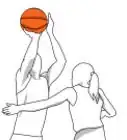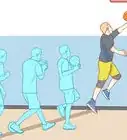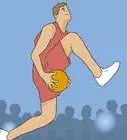This article was co-authored by Ryan Tremblay. Ryan Tremblay is a Basketball Coach and the Owner of National Sports ID and STACK Basketball. With over 30 years of experience, Ryan specializes in basketball coaching, social media marketing, and website design. Ryan created the National Sports ID as a platform to verify the age/grade of youth athletes and STACK Basketball to inspire young athletes to grow into mature individuals and basketball players. Ryan was a First Team All-Decade basketball player in Bergen County and finished in the top 20 all-time leading scorers in the county’s history with 1,730 points. He went on to Caldwell University on a basketball scholarship where he was part of three championship teams. Ryan was a two-time All-Metropolitan, All-State, and All-Conference point guard and the all-time three-point leader in the school’s history, landing him in the Caldwell University Athletic Hall of Fame.
There are 9 references cited in this article, which can be found at the bottom of the page.
This article has been viewed 96,120 times.
Layups can be pretty hard to pull off, but if you work on your technique of laying the ball up to the sweet spot of the backboard, you'll slowly improve your performance. Making your layups is not about being fancy, rather, its about practice and skill. It’s about setting goals and being confident. Don't give up, commit plenty of time to practicing on your own and with others, and soon enough your technique will improve, your skill level will rise, and you'll be making your layups regularly.
Steps
Shooting a Layup
-
1Consider the underhand layup. You lay the ball with your hand under it. The ball leaves your hand gently and it causes a nice and smooth touch on the backboard. This is useful if you are driving your way towards the basket and are unable to slow down and take the time to aim.
-
2Use the overhand layup, if you prefer. The overhand layup is a great alternative to the underhand layup. You hold the ball on top of it as if you will be dunking, it produces more power to touch the backboard roughly. It is useful when you are on the low post.Advertisement
-
3Run into the shot, if you're using an underhand layup. Make sure you’re running into the shot. This is the key to the underhand layup, as during the game you’ll be dodging other players and running toward the basket. Don’t run too fast. When you’re practicing take it easy and try to perfect your skill.
-
4Perform a one foot layup, if appropriate. A one foot layup is what most people commonly do. It’s used when you’re moving toward the basket from far away with the ball, or when you’re moving toward the basket and you expect someone to throw you the ball to take a shot.
- Run toward the basket.
- Once you’re near, jump off one of your feet up toward the basket. You’ll probably jump with one foot (the left) and shoot with the other hand (the right).
- Practice this until you’re comfortable running toward the basket and jumping with one foot.[1]
-
5Consider a two foot layup. Sometimes it’s more appropriate to do a two foot layup. This is often when you’re positioned near the basket and someone passes the ball to you. When doing this layup, you’ll have to be prepared to catch a ball quickly and to shoot at a moment’s notice.
-
6Aim and shoot the ball gently at the "sweet spot.” After you’re positioned and have the ball, aim and shoot for the sweet spot. The sweet spot is the two corners of the square on the backboard which sits just above the basket. Laying the ball on this spot will assure you to make the shot.
- If you’re tall enough, you won’t have to aim for the sweet spot and can just shoot the ball directly into the basket.
- If you’re younger or just starting out, try to hit the sweet spot.
- Don’t shoot the ball with too much force, as it’ll probably bounce off and won’t go into the basket.
- Feel free to experiment without aiming for the sweet spot, if you are confident.
- Watch others who are more experienced shoot the ball and emulate their technique.[4] [5]
Practicing Your Layups
-
1Try layups on your own, without a ball. Before you hit the court with a ball and with other players, make sure to try doing your layups without a ball. Practice your running and jumping technique until you feel comfortable with it. This should help you build your own technique.[6]
-
2Practice your layups on your own, with a ball. Practice makes perfect, at least most of the time. When it comes to layups, this is true, too. Make sure to practice your layups with a ball on your own as much as you can.
-
3Add variation to your practice. Now that you’ve practiced a bit, add some variations to your approach. Variations will simulate the many situations you might find yourself in during an actual game. Try as many as possible, as you'll never really know what to expect in the heat of the moment.
- Practice coming at the basket from different angles.
- Practice coming at the basket from different speeds.
- Use cones or other obstacles on the court to simulate opposing players who will try to contest your layup.[7]
-
4Get some good competition to practice, before you play a full game. When you’re practicing your layups, you need to make sure you’ve got some pretty solid competition who is going to contest your layups. Find some friends who are pretty good on the court, and practice with them. Remember, though, you need to play against people who are as good as or better than you in order to improve your skill.
- Play full games and go out of your way to practice your layups against a skillful opponent.
- Ask skilled friends to let you practice layups against them.
- Realize that skillful competition is key.[8]
-
5Jump into a game and try your layup. Now that you’ve perfected your layups and practiced, find some friends and play a game. Take it easy, though. Try to find a few friends who want to play a low-stress game. This’ll be the best way for you to test your skills without the stress of a normal match. Don’t worry if you miss some layups, that’s part of learning.
- Keep practicing on your own after the game.
- Keep practicing with friends.
- Keep finding games to play in order to perfect your skills.[9]
Expert Q&A
-
QuestionWhat is the primary key to making layups?
 Ryan TremblayRyan Tremblay is a Basketball Coach and the Owner of National Sports ID and STACK Basketball. With over 30 years of experience, Ryan specializes in basketball coaching, social media marketing, and website design. Ryan created the National Sports ID as a platform to verify the age/grade of youth athletes and STACK Basketball to inspire young athletes to grow into mature individuals and basketball players. Ryan was a First Team All-Decade basketball player in Bergen County and finished in the top 20 all-time leading scorers in the county’s history with 1,730 points. He went on to Caldwell University on a basketball scholarship where he was part of three championship teams. Ryan was a two-time All-Metropolitan, All-State, and All-Conference point guard and the all-time three-point leader in the school’s history, landing him in the Caldwell University Athletic Hall of Fame.
Ryan TremblayRyan Tremblay is a Basketball Coach and the Owner of National Sports ID and STACK Basketball. With over 30 years of experience, Ryan specializes in basketball coaching, social media marketing, and website design. Ryan created the National Sports ID as a platform to verify the age/grade of youth athletes and STACK Basketball to inspire young athletes to grow into mature individuals and basketball players. Ryan was a First Team All-Decade basketball player in Bergen County and finished in the top 20 all-time leading scorers in the county’s history with 1,730 points. He went on to Caldwell University on a basketball scholarship where he was part of three championship teams. Ryan was a two-time All-Metropolitan, All-State, and All-Conference point guard and the all-time three-point leader in the school’s history, landing him in the Caldwell University Athletic Hall of Fame.
Basketball Coach The best way to get really confident with your layups is to practice doing them over and over again.
The best way to get really confident with your layups is to practice doing them over and over again. -
QuestionWhat foot should you go off for a layup?
 Ryan TremblayRyan Tremblay is a Basketball Coach and the Owner of National Sports ID and STACK Basketball. With over 30 years of experience, Ryan specializes in basketball coaching, social media marketing, and website design. Ryan created the National Sports ID as a platform to verify the age/grade of youth athletes and STACK Basketball to inspire young athletes to grow into mature individuals and basketball players. Ryan was a First Team All-Decade basketball player in Bergen County and finished in the top 20 all-time leading scorers in the county’s history with 1,730 points. He went on to Caldwell University on a basketball scholarship where he was part of three championship teams. Ryan was a two-time All-Metropolitan, All-State, and All-Conference point guard and the all-time three-point leader in the school’s history, landing him in the Caldwell University Athletic Hall of Fame.
Ryan TremblayRyan Tremblay is a Basketball Coach and the Owner of National Sports ID and STACK Basketball. With over 30 years of experience, Ryan specializes in basketball coaching, social media marketing, and website design. Ryan created the National Sports ID as a platform to verify the age/grade of youth athletes and STACK Basketball to inspire young athletes to grow into mature individuals and basketball players. Ryan was a First Team All-Decade basketball player in Bergen County and finished in the top 20 all-time leading scorers in the county’s history with 1,730 points. He went on to Caldwell University on a basketball scholarship where he was part of three championship teams. Ryan was a two-time All-Metropolitan, All-State, and All-Conference point guard and the all-time three-point leader in the school’s history, landing him in the Caldwell University Athletic Hall of Fame.
Basketball Coach I think it's best to start by learning to go off your right foot, then switch to the other foot when you get that down. Once you've gotten comfortable doing both, you can choose which one is best for you.
I think it's best to start by learning to go off your right foot, then switch to the other foot when you get that down. Once you've gotten comfortable doing both, you can choose which one is best for you. -
QuestionHow do I dribble efficiently?
 Wadood AlliCommunity AnswerKeep the ball moving at all times, unless you are attempting to pass the ball to a teammate. Make sure you keep an eye on your challenger's movements as this is a key component to efficient dribbling. For example; you are faced with an opponent and they approach you but are not central (right/left), you dribble in the other direction but be wary some players don't approach centrally as a method of trapping the dribbler. To summarize: practice regularly (especially with others), learn new skills and tricks, and always be aware of the ball's position.
Wadood AlliCommunity AnswerKeep the ball moving at all times, unless you are attempting to pass the ball to a teammate. Make sure you keep an eye on your challenger's movements as this is a key component to efficient dribbling. For example; you are faced with an opponent and they approach you but are not central (right/left), you dribble in the other direction but be wary some players don't approach centrally as a method of trapping the dribbler. To summarize: practice regularly (especially with others), learn new skills and tricks, and always be aware of the ball's position.
References
- ↑ http://hoopsu.com/how-to-shoot-a-layup/
- ↑ http://hoopsu.com/how-to-shoot-a-layup/
- ↑ Ryan Tremblay. Basketball Coach. Expert Interview. 9 March 2021.
- ↑ http://phys.org/news/2011-03-sweet-backboard.html
- ↑ https://www.breakthroughbasketball.com/fundamentals/layups.html
- ↑ http://www.online-basketball-drills.com/shooting-layups-basics-part-1
- ↑ http://espn.go.com/high-school/girls-basketball/story/_/id/7934696/practice-key-eliminating-missed-layups
- ↑ http://espn.go.com/high-school/girls-basketball/story/_/id/7934696/practice-key-eliminating-missed-layups
- ↑ http://ballerbootcamp.com/how-to-shoot-a-layup-in-basketball/
- ↑ http://www.stack.com/a/power-layup
- Videos provided by iSportdotcom's channel
About This Article
Layups can be one of the hardest parts of basketball, but if you train properly, you’ll be able to make them more and more often. Practice both overhand and underhand layups. For overhand layups, run into the shot and jump off 1 foot. For underhand layups, jump from 2 feet instead. Aim for the top corners of the backboard square, which should bounce the ball right into the basket. Practice layups on your own coming from different angles and moving at different speeds to improve your game. Once you’re confident with that, bring in an opponent to block you for a more realistic drill. For more tips, including how to practice layups in a game, read on!



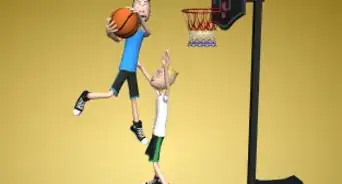
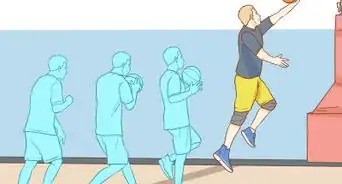
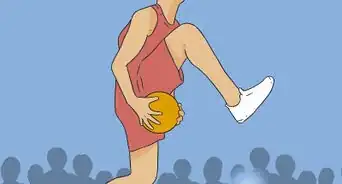
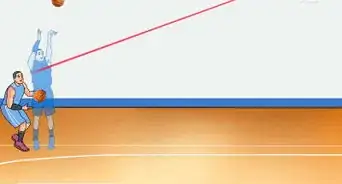
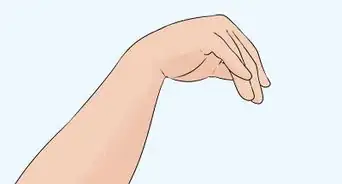
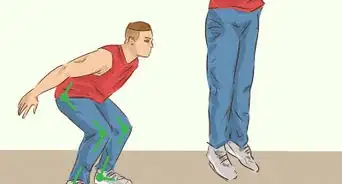
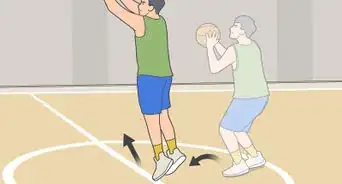
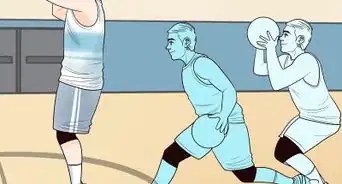
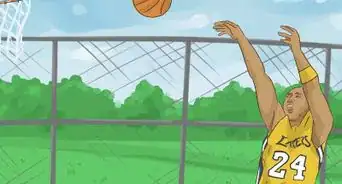
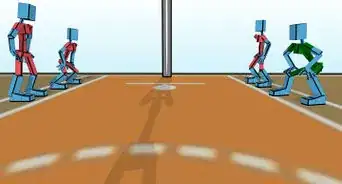
-Step-13.webp)











